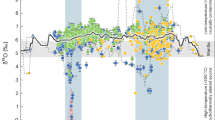Abstract
Geophysical models of the electrical conductivity of the Earth's mantle based on the observed variations of electric and magnetic fields at the surface of the Earth yield estimates of about 1 S m−1 for the conductivity of the uppermost lower mantle1,2. But laboratory conductivity measurements on silicate perovskite (thought to be the dominant constituent of the lower mantle) at high pressures have given conflicting estimates of mantle conductivity, ranging from less than 10−5 up to 1 S m−1 (3–6). Here we present measurements of the electrical conductivity of perovskite in a multi-anvil press at conditions appropriate for the uppermost lower mantle (pressures up to 23 GPa and temperatures up to 2,000 K). We find that the geophysical estimate of lower-mantle electrical conductivity can be well explained by the conductivity of the perovskite component of a low-oxygen-fugacity mantle composed of pyrolite7 (the assemblage of mineral phases thought to broadly represent that of the Earth's mantle), assuming a standard geotherm. Our results also indicate that the temperature dependence of perovskite conductivity at lower-mantle temperatures and pressures is significantly larger than shown previously; extrapolations of low-temperature conductivity measurements to the higher temperatures of the lower mantle should therefore be treated with caution.
This is a preview of subscription content, access via your institution
Access options
Subscribe to this journal
Receive 51 print issues and online access
$199.00 per year
only $3.90 per issue
Buy this article
- Purchase on Springer Link
- Instant access to full article PDF
Prices may be subject to local taxes which are calculated during checkout


Similar content being viewed by others
References
Egbert, G. D. & Booker, J. R. Very long period magnetotellurics at Tucson observatory: implication for mantle conductivity. J. Geophys. Res. 97, 15099–15112 (1992).
Schulz, A., Kurtz, R. D., Chave, A. D. & Jones, A. G. Conductivity discontinuity in the upper mantle beneath a stable craton. Geophys. Res. Lett. 20, 2941–2944 (1993).
Li, X.-Y. & Jeanloz, R. Electrical conductivity of (Mg,Fe)SiO3perovskite and perovskite-dominated assemblage at lower mantle conditions. Geophys. Res. Lett. 14, 1075–1078 (1987).
Li, X.-Y. & Jeanloz, R. Laboratory studies of the electrical conductivity of silicate perovskites at high pressures and high temperatures. J. Geophys. Res. 95, 2067–5078 (1990).
Peyronneau, J. & Poirier, J. P. Electrical conductivity of Earth's lower mantle. Nature 342, 537–539 (1989).
Shankland, T. J., Peyronneau, J. & Poirier, J. P. Electrical conductivity of Earth's lower mantle. Nature 366, 453–455 (1993).
Ringwood, A. E. Origin of the Earth and Moon (Spinger, New York, 1979).
Katsura, T. & Ito, E. Determination of Fe-Mg partitioning between perovskite and magnesiowüstite. Geophys. Res. Lett. 23, 2005–2008 (1996).
Katsura, T., Sato, K. & Ito, E. Electrical conductivity measurement of minerals at high pressures and high temperatures. Rev. High Pressure Sci. Technol. 7, 18–21 (1998).
Ito, E., Kubo, A., Katsura, T., Akaogi, M. & Fujita, T. High-pressure transformation of pyrope (Mg3Al2Si3O12) in a sintered diamond cubic anvil assembly. Geophys. Res. Lett. 25, 821–824 (1998).
Wood, B. J. & Nell, J. High-temperature electrical conductivity of the lower-mantle phase (Mg,Fe)O. Nature 351, 309–311 (1991).
Ito, E. & Katsura, T. Atemperature profile in the mantle transition zone. Geophys. Res. Lett. 16, 425–428 (1989).
Dobson, D. P., Richmond, N. C. & Brodholt, J. P. Ahigh-temperature electrical conduction mechanism in the lower mantle phase (Mg,Fe)1−xO. Science 273, 1779–1781 (1997).
Martinez, I., Wang, Y., Guyot, F., Liebermann, R. C. & Doukhan, J.-C. Microstructures and iron partioning in (Mg,Fe)Sio2perovskite-(Mg,Fe)O magnesiowüstite assemblages: an analytical transmission electron microscopy study. J. Geophys. Res. 102, 5256–5280 (1997).
Irifune, T. Absence of an aluminous phase in the upper part of the Earth's lower mantle. Nature 370, 131–133 (1994).
McCammon, C. Perovskite as a possible sink for ferric iron in the lower mantle. Nature 387, 694–696 (1997).
Acknowledgements
We thank M. J. Walter and J. Brodholt for comments.
Author information
Authors and Affiliations
Corresponding author
Rights and permissions
About this article
Cite this article
Katsura, T., Sato, K. & Ito, E. Electrical conductivity of silicate perovskite at lower-mantle conditions. Nature 395, 493–495 (1998). https://doi.org/10.1038/26736
Received:
Accepted:
Issue Date:
DOI: https://doi.org/10.1038/26736
This article is cited by
-
First-principles investigations of structural, elastic and electronic properties of hydrous fayalite
Arabian Journal of Geosciences (2022)
-
Incorporation mechanism of Fe and Al into bridgmanite in a subducting mid-ocean ridge basalt and its crystal chemistry
Scientific Reports (2021)
-
Some remarks on hydrogen-assisted electrical conductivity in olivine and other minerals
Progress in Earth and Planetary Science (2019)
-
Low-Wave-Velocity and High-Electrical-Conductivity Layer of Serpentine: A Compilation
Pure and Applied Geophysics (2019)
-
Experimental study of the electrical conductivity of hydrous minerals in the crust and the mantle under high pressure and high temperature
Science China Earth Sciences (2016)
Comments
By submitting a comment you agree to abide by our Terms and Community Guidelines. If you find something abusive or that does not comply with our terms or guidelines please flag it as inappropriate.



